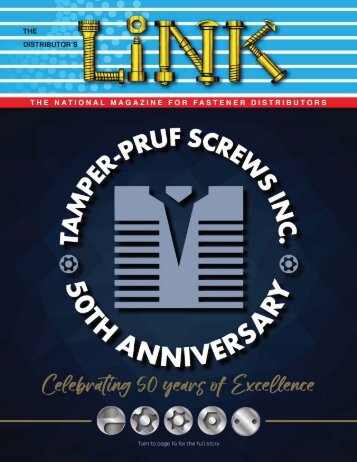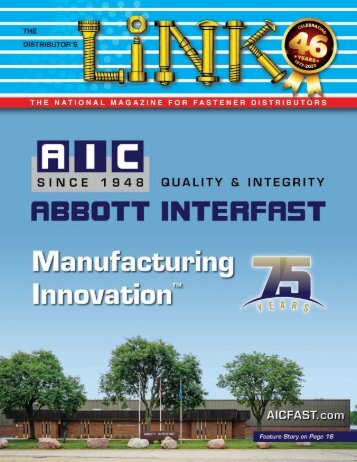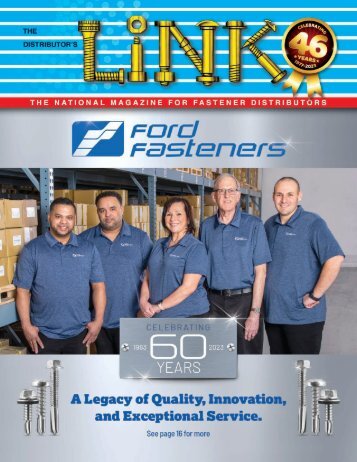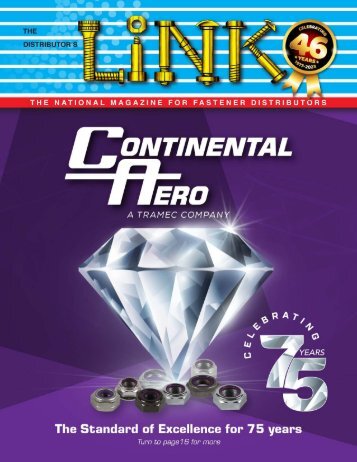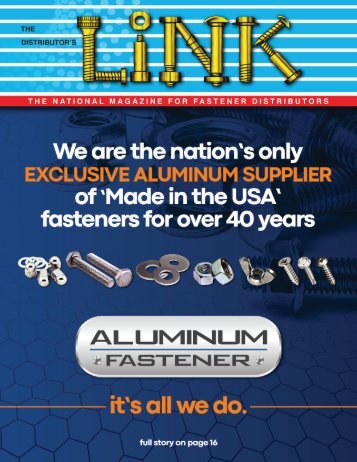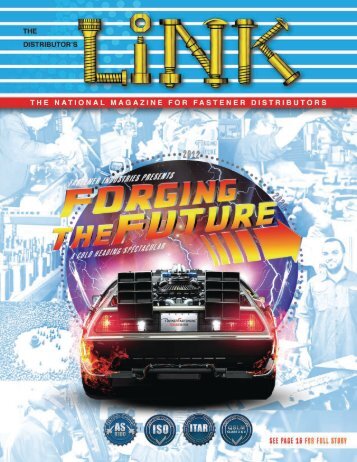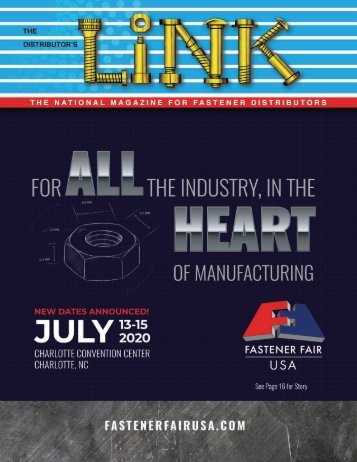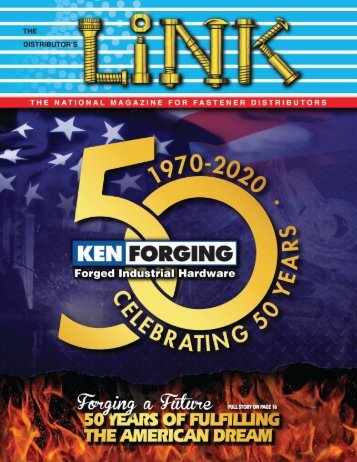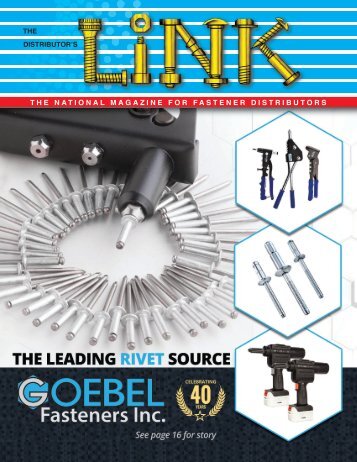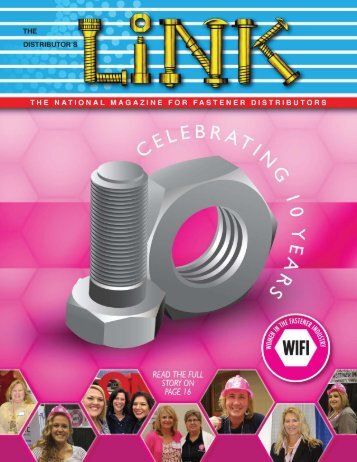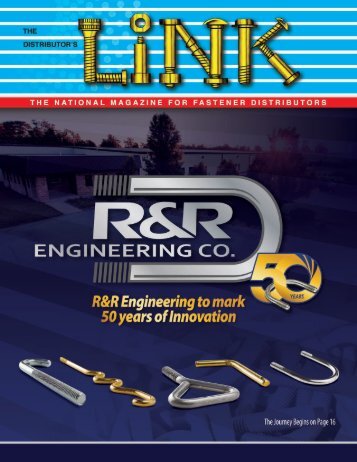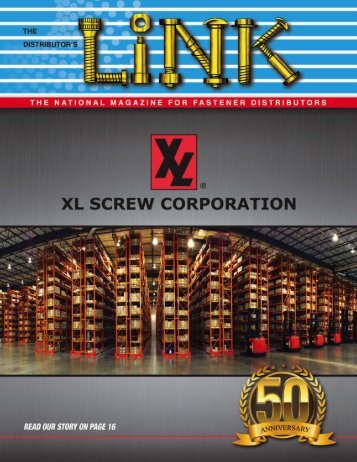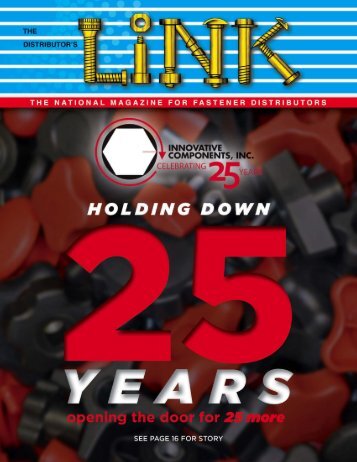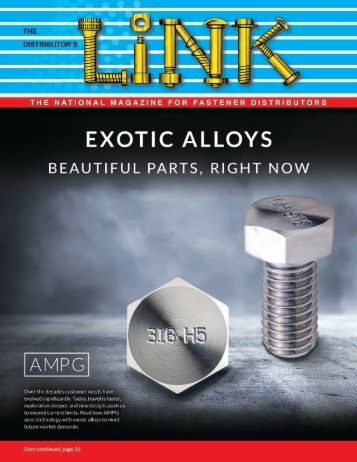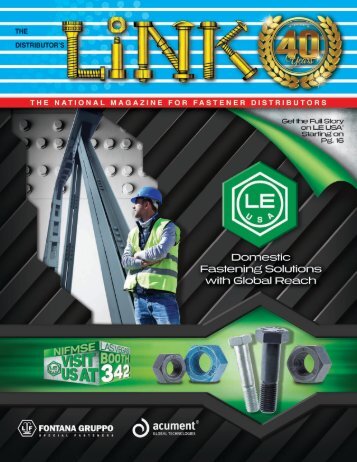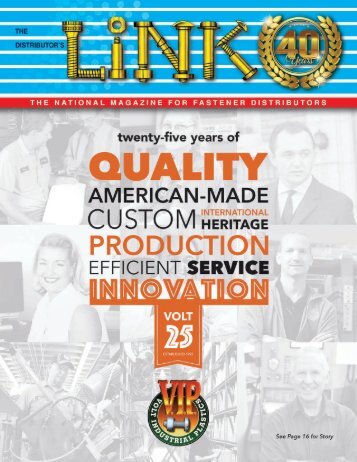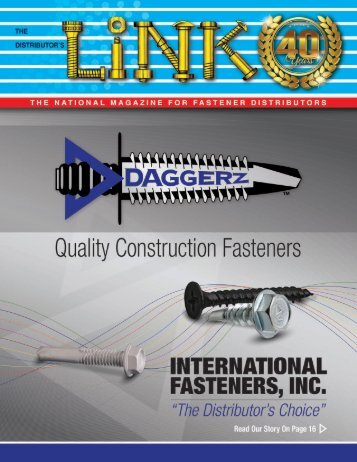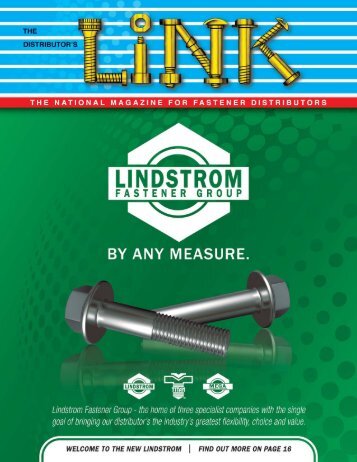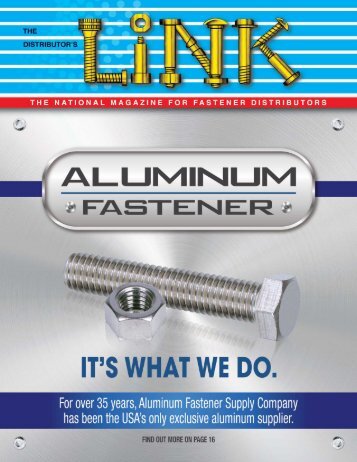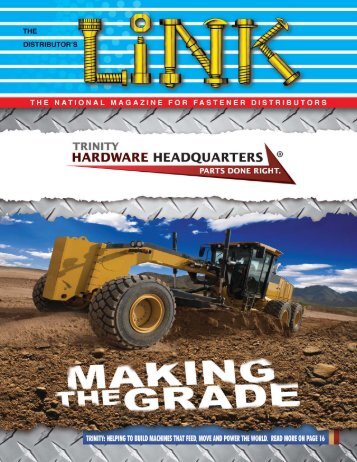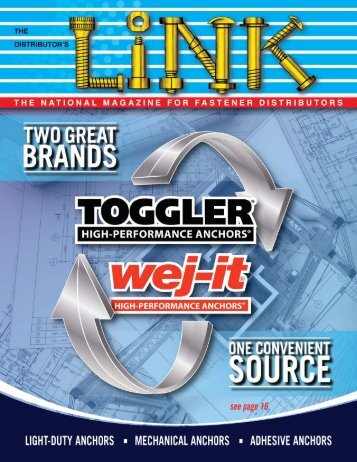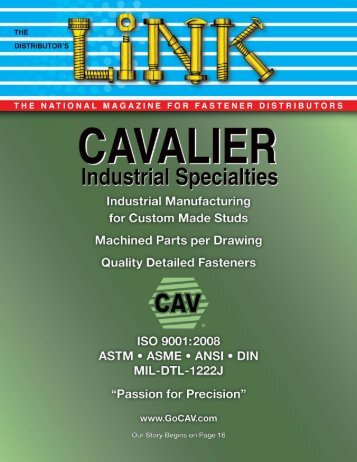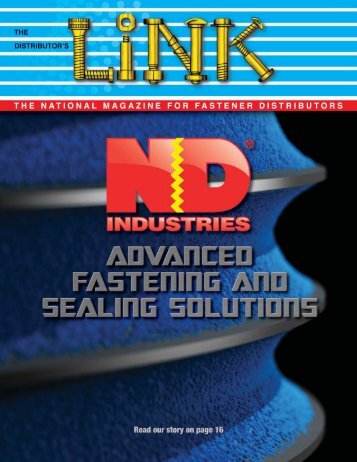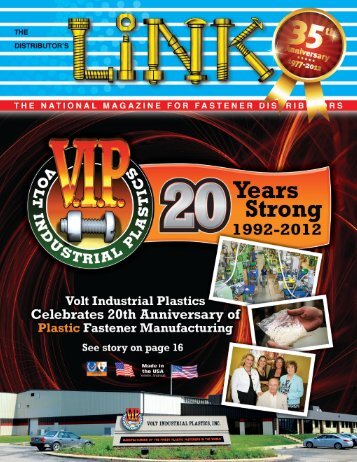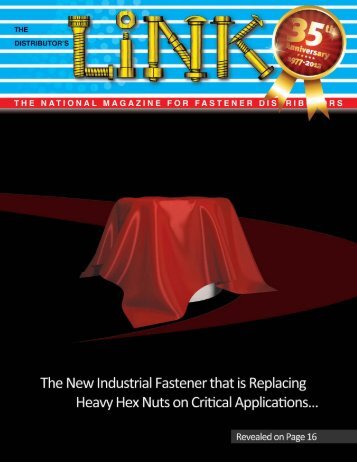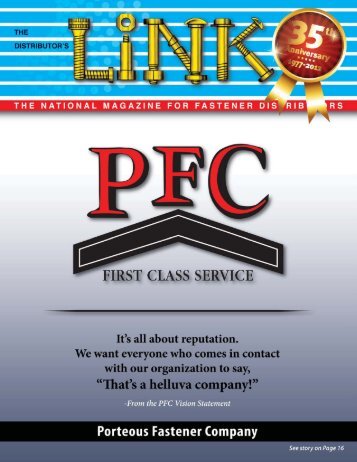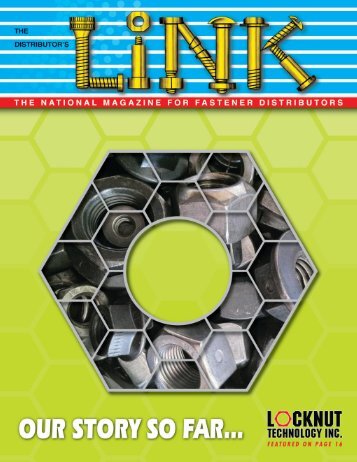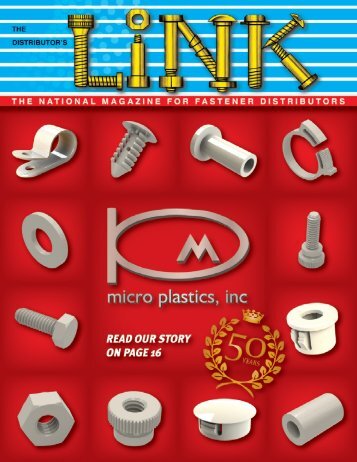SUMMER 2017
- Text
- Fastener
- Fasteners
- Products
- Industrial
- Distributors
- Association
- Phillips
- Bolt
- Continued
- Fracture
26 THE DISTRIBUTOR’S
26 THE DISTRIBUTOR’S LINK Guy Avellon Guy Avellon has been in MRO and Fastener Distribution for over 30 years, in such positions Sales Engineer, Chief Engineer, Manager of Product Marketing, Product Engineering & Quality and Director of Quality & Engineering. He founded GT Technical Consultants where he performs failure analysis, lectures on fastener safety, works for law firms and designs/audits Quality systems. He is a member of SAE, is Vice Chairman of the ASTM F16 Fastener Committee, Chairman of the F16.01 Test Methods Committee and received the ASTM Award of Merit in 2005. Guy can be contacted at 847- 477-5057, Email: ExpertBoltGuy@gmail.com or visit www.BoltFailure.com. WHAT FASTENER DISTRIBUTORS NEED TO KNOW ABOUT KEEPING FASTENERS TIGHT - PART 2 In the previous article, Part 1, I stated that there was no single product that will serve the needs for vibrational resistance for all applications without having some limitations. This is why we have such a variety of products on the market. However, there is one universal product that has been around since the flood waters have receded: the lock washer. Billions of lock washers are manufactured and sold every year. Why do we use so many of these when there is a variety of other locking devices available on the market that offer far superior performance to the venerable lock washer? Convenience, habit, easy to use or inexpensive? As far back as 1969, the SAE (Society of Automotive Engineers) recommended against the use of helical spring lock washers with any Grade 8 (10.9) fastener and in any critical application. In the early 1980s, the specifications were removed from the SAE Handbook. Since then, there has been no automotive fastener assembled with a lock washer, especially on a Grade 8 or 10.9 fastener used in a critical application. However, specifications and testing methods can still be found in the IFI (Industrial Fasteners Institute) Handbook referencing the ANSI/ASME B18.21.1. Originally, lock washers were manufactured from a medium-high carbon steel and heat treated to a range of 45-56 Rc. They were furnished either as treated or electroplated with zinc. However, this presented problems with hydrogen embrittlement (Figure 1). Hydrogen embrittlement is a delayed but sudden brittle fracture caused by the absorption of atomic hydrogen into the steel from the cleaning and plating processes. Over the past several decades, lock washers have been made from a medium carbon steel heat treated up to a hardness of 45 Rc. The common practice now is to have CONTRIBUTOR ARTICLE FIGURE 1 the lock washers mechanically plated with zinc metal flakes to minimize the potential for hydrogen embrittlement. Since the hardnesses of the lock washers were lowered, a new problem developed with some overseas manufacturers: they were too soft. The opened part simply spread open even further when assembled (Figure 2). FIGURE 2 The common lock washer is a helical spring. At one point in time it was referred to as a ‘split washer’ since the ends are open. One end is bent slightly upwards, the other end is bent slightly downwards. Both of these ends have sharp end corners from the forming operation, which may help to secure the lock washer by digging into its respective surface. CONTINUED ON PAGE 104
- Page 6 and 7: in thesummer2017 issue of 6 DISTRIB
- Page 8: 6 THE DISTRIBUTOR’S LINK Distribu
- Page 12: 10 THE DISTRIBUTOR’S LINK Laurenc
- Page 16: 14 THE DISTRIBUTOR’S LINK FASTENE
- Page 30: 28 THE DISTRIBUTOR’S LINK FASTENE
- Page 36 and 37: 34 THE DISTRIBUTOR’S LINK Robert
- Page 38: 36 THE DISTRIBUTOR’S LINK Jim Rue
- Page 42: 40 THE DISTRIBUTOR’S LINK NAW INS
- Page 45 and 46: THE DISTRIBUTOR’S LINK 43 Earnest
- Page 48 and 49: 46 THE DISTRIBUTOR’S LINK MID-WES
- Page 50: 48 THE DISTRIBUTOR’S LINK Jim Tru
- Page 54 and 55: 52 THE DISTRIBUTOR’S LINK GLOBALF
- Page 56: 54 THE DISTRIBUTOR’S LINK NATIONA
- Page 59 and 60: THE DISTRIBUTOR’S LINK 57 The Aut
- Page 61 and 62: THE DISTRIBUTOR’S LINK 59
- Page 64 and 65: 62 THE DISTRIBUTOR’S LINK Innovat
- Page 66 and 67: 64 THE DISTRIBUTOR’S LINK KEY BEL
- Page 68 and 69: 66 THE DISTRIBUTOR’S LINK CABLE T
- Page 70 and 71: 68 THE DISTRIBUTOR’S LINK Jo Morr
- Page 72: 70 THE DISTRIBUTOR’S LINK PACIFIC
- Page 75 and 76: THE DISTRIBUTOR’S LINK 73
- Page 77 and 78:
THE DISTRIBUTOR’S LINK 75 NCFA DI
- Page 79 and 80:
THE DISTRIBUTOR’S LINK 77 Bolt Ex
- Page 82 and 83:
80 THE DISTRIBUTOR’S LINK NEW ENG
- Page 84 and 85:
82 THE DISTRIBUTOR’S LINK OBITUAR
- Page 86:
84 THE DISTRIBUTOR’S LINK GLOBALF
- Page 89 and 90:
Innovative Components Inc has recen
- Page 92 and 93:
90 THE DISTRIBUTOR’S LINK NATIONA
- Page 94:
92 THE DISTRIBUTOR’S LINK Bay Sup
- Page 97 and 98:
THE DISTRIBUTOR’S LINK 95 WORDSEA
- Page 100 and 101:
98 THE DISTRIBUTOR’S LINK JOE DYS
- Page 102:
100 THE DISTRIBUTOR’S LINK FASTEN
- Page 105 and 106:
DDI System, a leading ERP software
- Page 108 and 109:
106 THE DISTRIBUTOR’S LINK FIC FA
- Page 110:
108 THE DISTRIBUTOR’S LINK PHILLI
- Page 113 and 114:
THE DISTRIBUTOR’S LINK 111
- Page 115 and 116:
THE DISTRIBUTOR’S LINK 113 UNICOR
- Page 117 and 118:
THE DISTRIBUTOR’S LINK 115 SOUTHE
- Page 120:
118 THE DISTRIBUTOR’S LINK MWFA 6
- Page 124:
122 THE DISTRIBUTOR’S LINK NIFMSE
- Page 127 and 128:
PWFA AFTER HOURS EVENT - ANAHEIM, C
- Page 129 and 130:
THE DISTRIBUTOR’S LINK 127 SUDOKU
- Page 132 and 133:
130 THE DISTRIBUTOR’S LINK KEY BE
- Page 135 and 136:
VOLT INDUSTRIAL PLASTICS 25th ANNIV
- Page 137 and 138:
fastenerlinks BRINGING YOU THE FAST
- Page 139 and 140:
fastenerlinks BRINGING YOU THE FAST
- Page 142 and 143:
140 THE DISTRIBUTOR’S LINK CABLE
- Page 144 and 145:
142 THE DISTRIBUTOR’S LINK PWFA P
- Page 146:
144 THE DISTRIBUTOR’S LINK MWFA F
- Page 149 and 150:
NEFDA 29th ANNUAL SCHOLARSHIP GOLF
- Page 151 and 152:
THE DISTRIBUTOR’S LINK 149
- Page 154 and 155:
152 THE DISTRIBUTOR’S LINK BENGT
- Page 156 and 157:
154 THE DISTRIBUTOR’S LINK LAUREN
- Page 158 and 159:
156 THE DISTRIBUTOR’S LINK FASTEN
- Page 160:
158 THE DISTRIBUTOR’S LINK COMPUT
- Page 163 and 164:
FASTENER TECH ’17 - ALL INDUSTRY
- Page 165 and 166:
THE DISTRIBUTOR’S LINK 163
- Page 168 and 169:
166 THE DISTRIBUTOR’S LINK JIM RU
- Page 170 and 171:
168 THE DISTRIBUTOR’S LINK SPIROL
- Page 172 and 173:
170 THE DISTRIBUTOR’S LINK ACE BO
- Page 174:
172 THE DISTRIBUTOR’S LINK BENGT
- Page 177 and 178:
FASTENER TECH ’17 - ALL INDUSTRY
- Page 179 and 180:
FASTENER TECH ’17 ROSEMONT, CHICA
- Page 182 and 183:
180 THE DISTRIBUTOR’S LINK BENGT
- Page 184 and 185:
182 THE DISTRIBUTOR’S LINK LAUREN
- Page 186:
184 THE DISTRIBUTOR’S LINK COMPUT
- Page 190:
advertisers index D DARLING BOLT 15
- Page 194:
advertisers index R RAF ELECTRONIC
Inappropriate
Loading...
Mail this publication
Loading...
Embed
Loading...
|
SHARE A PAGE FROM THIS MAGAZINE OPTION 1: Click on the share tab above, or OPTION 2: Click on the icon (far right of toolbar) and then click on the icon (far right of toolbar) and then click on the  icon (top right of the page). icon (top right of the page).
|
View Archives
Copyright © Distributor's Link, Inc. All Rights Reserved | Privacy Policy







